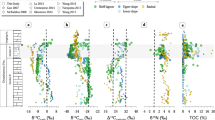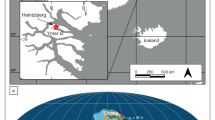Abstract
Variations of the Earth’s atmospheric oxygen concentration (pO2) are thought to be closely tied to the evolution of life, with strong feedbacks between uni- and multicellular life and oxygen1,2. On the geologic timescale, pO2 is regulated by the burial of organic carbon and sulphur, as well as by weathering3. Reconstructions of atmospheric O2 for the past 400 million years have therefore been based on geochemical models of carbon and sulphur cycling4,5,6. However, these reconstructions vary widely4,5,6,7,8,9,10, particularly for the Mesozoic and early Cenozoic eras. Here we show that the abundance of charcoal in mire settings is controlled by pO2, and use this proxy to reconstruct the concentration of atmospheric oxygen for the past 400 million years. We estimate that pO2 was continuously above 26% during the Carboniferous and Permian periods, and that it declined abruptly around the time of the Permian–Triassic mass extinction. During the Triassic and Jurassic periods, pO2 fluctuated cyclically, with amplitudes up to 10% and a frequency of 20–30 million years. Atmospheric oxygen concentrations have declined steadily from the middle of the Cretaceous period to present-day values of about 21%. We conclude, however, that variation in pO2 was not the main driver of the loss of faunal diversity during the Permo–Triassic and Triassic–Jurassic mass extinction events.
This is a preview of subscription content, access via your institution
Access options
Subscribe to this journal
Receive 12 print issues and online access
$259.00 per year
only $21.58 per issue
Buy this article
- Purchase on Springer Link
- Instant access to full article PDF
Prices may be subject to local taxes which are calculated during checkout

Similar content being viewed by others
References
Flück, M. et al. Coping with cyclic oxygen availability: Evolutionary aspects. Integr. Comp. Biol. 47, 324–331 (2007).
Watson, A., Lovelock, J. E. & Margulis, L. Methanogenesis, fires and the regulation of atmospheric oxygen. Biosystems 10, 293–298 (1978).
Kump, L. R. Terrestrial feedback in atmospheric oxygen regulation by fire and phosphorous. Nature 335, 152–154 (1988).
Falkowski, P. G. et al. The rise of oxygen over the past 205 million years and the evolution of large placental mammals. Science 309, 2202–2204 (2005).
Berner, R. A. GEOCARBSULF: A combined model for Phanerozoic atmospheric O2 and CO2 . Geochim. Cosmochim. 70, 5653–5664 (2006).
Berner, R. A. Phanerozoic atmospheric oxygen: New results using the GEOCARBSULF model. Am. J. Sci. 309, 603–606 (2009).
Berner, R. A. & Canfield, D. E. A new model for atmospheric oxygen over Phanerozoic time. Am. J. Sci. 289, 333–361 (1989).
Hansen, K. W. & Wallmann, K. Cretaceous and Cenozoic evolution of seawater composition, atmospheric O2 and CO2: A model perspective. Am. J. Sci. 303, 94–148 (2003).
Bergman, N. M., Lenton, T. M. & Watson, A. J. COPSE: A new model of biogeochemical cycling over Phanerozoic time. Am. J. Sci. 304, 397–437 (2004).
Arvidson, R. S. & Mackenzie, F. T. MAGic: A Phanerozoic model for the geochemical cycling of major rock-forming components. Am. J. Sci. 306, 155–190 (2006).
Jones, T. P. & Chaloner, W. G. Fossil charcoal, its recognition and paleoatmospheric significance. Palaeogeogr. Palaeoclimatol. Palaeoecol. 97, 39–50 (1991).
Glasspool, I. J., Edwards, D. & Axe, L. Charcoal in the Silurian as evidence for the earliest wildfire. Geology 32, 381–383 (2004).
Bowman, D. M. J. S. et al. Fire in the Earth system. Science 324, 481–484 (2009).
Scott, A. C. The pre-quaternary history of fire. Palaeogeogr. Palaeoclimatol. Palaeoecol. 164, 281–329 (2000).
Wildman, R. A. et al. Burning of forest materials under late Paleozoic high atmospheric oxygen levels. Geology 32, 457–460 (2004).
Belcher, C. M. & McElwain, J. C. Limits for combustion in low O2 redefine paleoatmospheric predictions for the Mesozoic. Science 321, 1197–1200 (2008).
Cope, M. J. & Chaloner, W. G. Fossil charcoal as evidence of past atmospheric composition. Nature 283, 647–649 (1980).
Christian, H. J. et al. Global frequency and distribution of lightning as observed from space by the optical transient detector. J. Geophys. Res. 108, 4005 (2003).
Scott, A. C. & Jones, T. P. Fossil charcoal: A plant-fossil record preserved by fire. Geol. Today 7, 214–216 (1991).
Whelan, R. J. The Ecology of Fire (Cambridge Univ. Press, 1995).
Taylor, G. H. et al. Organic Petrology (Gebruder Borntraeger, 1998).
Scott, A. C. & Glasspool, I. J. Observations and experiments on the origin and formation of inertinite group macerals. Int. J. Coal Geol. 70, 53–66 (2007).
Diessel, C. F. K. The stratigraphic distribution of inertinite. Int. J. Coal Geol. 81, 251–268 (2010).
Robinson, J. M. Phanerozoic atmospheric reconstructions: A terrestrial perspective. Palaeogeogr. Palaeoclimatol. Palaeoecol. 97, 51–62 (1991).
Lenton, T. M. & Watson, A. J. Redfield revisited: 2. What regulates the oxygen content of the atmosphere. Glob. Biogeochem. Cycles 14, 249–268 (2000).
Beerling, D. J. et al. Carbon isotope evidence implying high O2/CO2 ratios in the Permo-Carboniferous atmosphere. Geochim. Cosmochim. Acta 66, 3757–3767 (2002).
Robinson, J. M. Phanerozoic O2 variation, fire, and terrestrial ecology. Palaeogeogr. Palaeoclimatol. Palaeoecol. 75, 223–240 (1989).
Retallack, G. J. et al. Middle-Late Permian mass extinction on land. Geol. Soc. Am. Bull. 118, 1398–1411 (2006).
Isozaki, Y. Permo–Triassic boundary superanoxia and stratified superocean: Records from lost deep sea. Science 276, 235–238 (1997).
Bond, W. J. The tortoise and the hare: Ecology of angiosperm dominance and gymnosperm persistence. Biol. J. Linn. Soc. 36, 227–249 (1989).
Acknowledgements
We thank the Grainger Fund at FMNH for financial support, and acknowledge R. A. Berner, W. G. Chaloner and A. J. Watson for helpful discussions. The work of A.C.S. is financially supported by private charitable donations.
Author information
Authors and Affiliations
Contributions
I.J.G. and A.C.S. designed the research. I.J.G. gathered, compiled and interpreted data and A.C.S. contributed data. I.J.G. wrote the paper with additions by A.C.S.
Corresponding author
Ethics declarations
Competing interests
The authors declare no competing financial interests.
Supplementary information
Supplementary Information
Supplementary Information (PDF 927 kb)
Rights and permissions
About this article
Cite this article
Glasspool, I., Scott, A. Phanerozoic concentrations of atmospheric oxygen reconstructed from sedimentary charcoal. Nature Geosci 3, 627–630 (2010). https://doi.org/10.1038/ngeo923
Received:
Accepted:
Published:
Issue Date:
DOI: https://doi.org/10.1038/ngeo923
This article is cited by
-
Variations in climate habitability parameters and their effect on Earth's biosphere during the Phanerozoic Eon
Scientific Reports (2023)
-
Phanerozoic oceanic and climatic perturbations in the context of Tethyan evolution
Science China Earth Sciences (2023)
-
Coal Seam Correlation in Terrestrial Basins by Sequence Stratigraphy and Its Implications for Paleoclimate and Paleoenvironment Evolution
Journal of Earth Science (2023)
-
Low atmospheric CO2 levels before the rise of forested ecosystems
Nature Communications (2022)
-
Increased fire activity under high atmospheric oxygen concentrations is compatible with the presence of forests
Nature Communications (2022)



